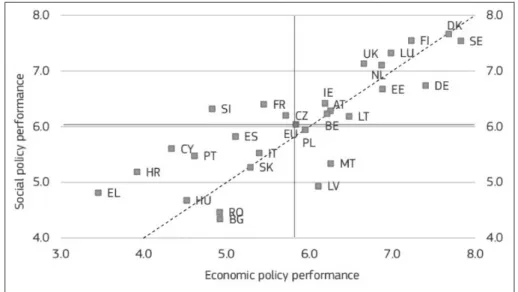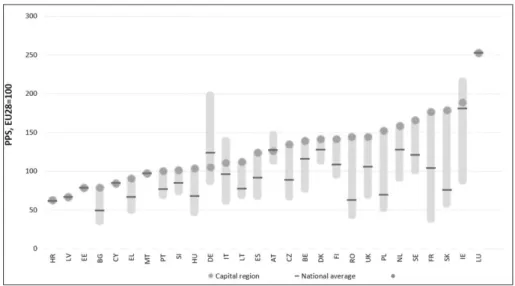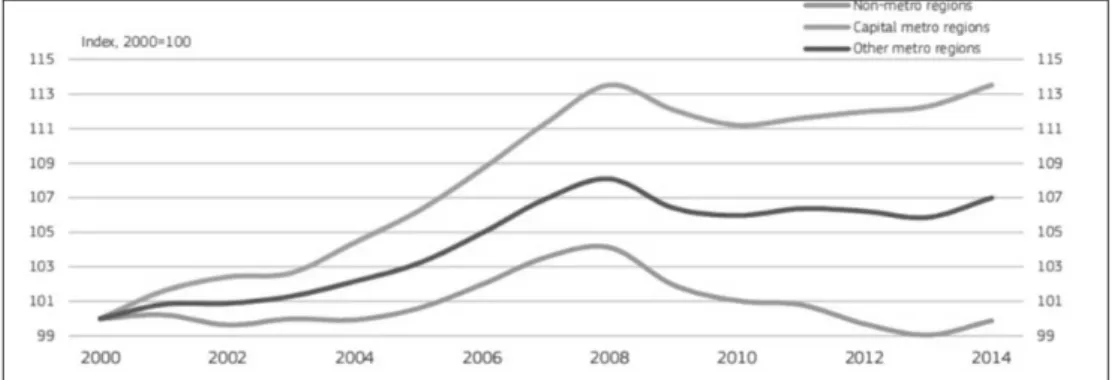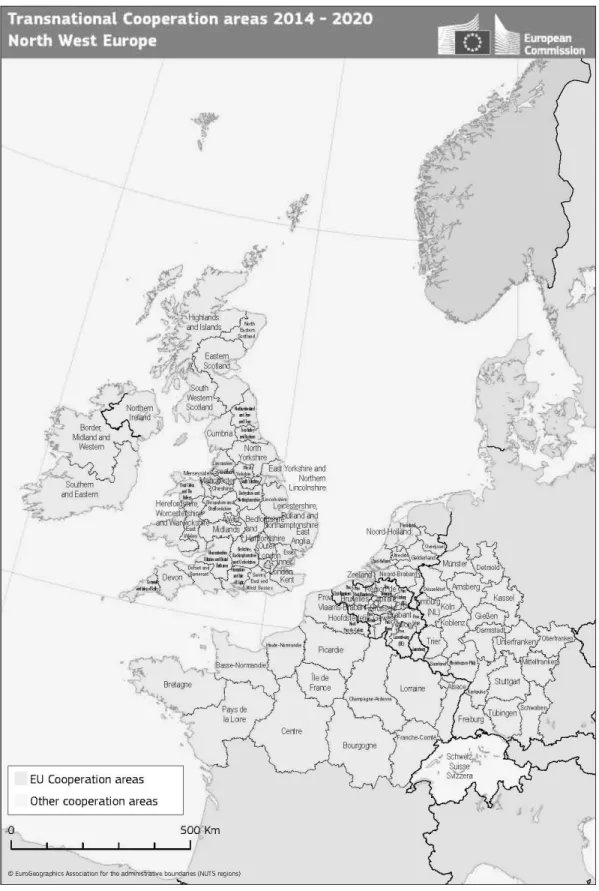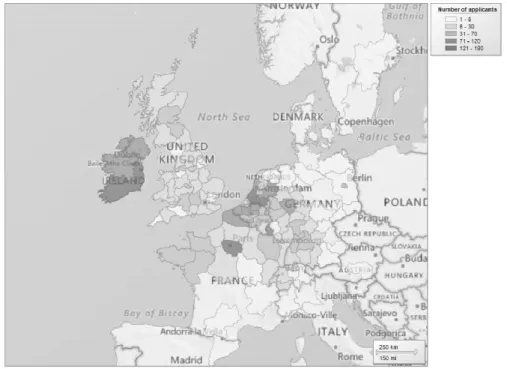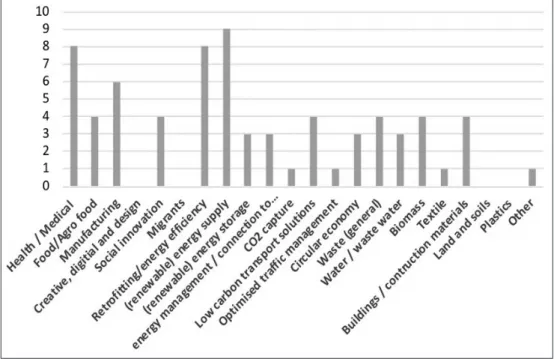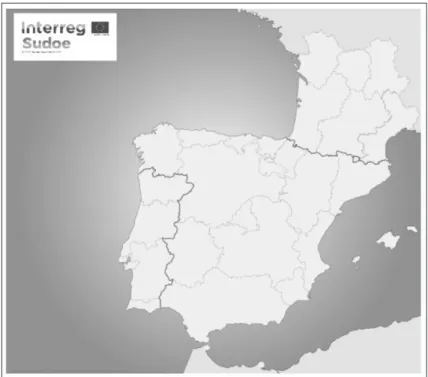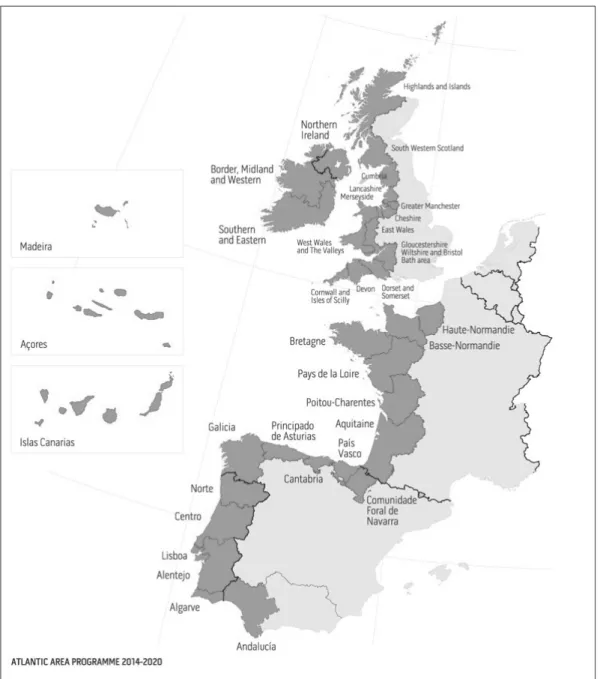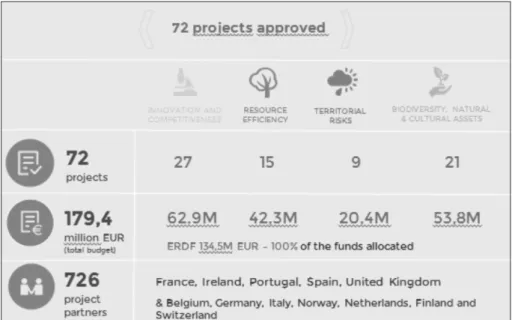European Transnational Cooperation in the
Making
The Added-Value of INTERREG-B
Eduardo Medeiros, Guus Muijzers, Rudolf (Ruut) Louwers, Isabelle Roger, Sandra Tavares da Silva *
The European transnational cooperation process, implemented via the ongoing 15 EU IN-TERREG-B programmes, is integrated in the second objective of EU Cohesion Policy: Euro-pean Territorial Cooperation. Aiming to promote better cooperation and regional develop-ment processes within the European Union by a joint approach to tackle common issues, the EU transnational cooperation programmes are key to tackling transnational development bottlenecks and to better exploring transnational territorial capitals. Currently, there are on-going discussions within the European Commission to delimit the new EU Cohesion Policy post-2020 INTERREG-B programmes. In this context, this article summarises the main con-clusions of four invited speakers of an international conference which took place on 21 June 2019 at the Instituto Universitário de Lisboa. The conference aimed to present some of the key contributions towards territorial development of the EU of EU Cohesion Policy and, in particular, of three INTERREG-B programmes: North West Europe (NWE), South West Eu-rope (SUDOE), and the Atlantic Area.
I. Introduction
Transnational cooperation is one of the three Terri-torial Cooperation processes supported by the Euro-pean Union (EU) since the 1990s, together with cross-border and interregional cooperation. More specifi-cally, and according to the European Commission (EC), ‘transnational cooperation, also known as IN-TERREG B, involves regions from several countries of the EU forming bigger areas. It aims to promote better cooperation and regional development within the Union by a joint approach to tackle common is-sues. INTERREG B supports a wide range of project investment related to innovation, environment, ac-cessibility, telecommunications, urban development
etc. The transnational programmes add an important extra European dimension to regional development, developed from analysis at a European level, leading to agreed priorities and a coordinated strategic re-sponse.1Currently, 15 INTERREG-B cooperation
pro-grammes are being implemented, financed through the European Regional Development Fund (ERDF) with around €2.1 billion for the period 2014-2020.
As the preparations for the next EU Cohesion Pol-icy (2021-27) phase take place, a wide debate within and outside the EC has sparked on the potential ‘new territorial delimitations’ of the post-2020 INTERREG-B programmes. In this context, the DINÂMIA’CET – IUL, a research unit of the Instituto Universitario de Lisboa (ISCTE-IUL) organised an international
con-* Eduardo Medeiros is a Geography Professor and an integrated researcher at the Instituto Universitário de Lisboa (ISCTE-IUL), DINÂMIA’CET – IUL, Lisboa, Portugal – Avenida das Forças Armadas, Edifício Sedas Nunes, Sala 2W4-d, 1649 – 026 Lisboa, Portugal. For corresponcence: Eduardo.Medeiros@iscte-iul.pt. He has a Ph.D. in Geography (Urban and Regional Development Studies) and is a DG REGIO and URBACT III expert.
Guus Muijzers, European Commission, DG Regional and Urban Policy (REGIO). For correspondence: Guus.Muijzers@ec.eu-ropa.eu (the information and views set out in this article are those
of the author and do not necessarily reflect the official opinion of the European Commission).
Rudolf (Ruut) Louwers, Director of the INTERREG-B North West Europe programme. For correspondence: ruut@nweurope.eu. Isabelle Roger, Director of the INTERREG-B SUDOE Joint Secre-tariat programme. For correspondence: isabelle.roger@interreg-sudoe.eu.
Sandra Tavares da Silva is a Professor at Faculdade de Economia da Universidade do Porto and an associated researcher at CEF.UP – Center for Economics and Finance. She has a Ph.D. in
Econom-EStIF 3 | 2019 156 The Added-value of INTERREG-B
ference to debate the main effects of the implemen-tation of EU transnational cooperation programmes and their future prospects.
With this in mind, four speakers with deep knowl-edge on the implementation of EU Cohesion Policy and EU transnational cooperation programmes were invited to participate in an international conference, which took place on 21 June 2019 at the Instituto Uni-versitário de Lisboa. The first speaker (Guus Muijz-ers) represented the European Commission and fo-cused mainly on presenting a critical overview of EU Cohesion Policy. Guus Muijzers is working at the EC, since 1992. In 2003 he joined the DG Regional and Urban Policy. He has a vast experience in EU Cohe-sion Policy and European Territorial Cooperation processes.
The next three speakers were invited because of their profound knowledge in implementing EU IN-TERREG-B programmes. The first (Rudolf Louwers) is the Director of the INTERREG North-West Europe (NWE) Programme since 2007, where he leads a mul-ti-national team of EU project experts with the mis-sion to support European Territorial Cohemis-sion. He was invited because the NWE INTERREG-B pro-gramme is known within the EC to be one of the best managed EU INTERREG-B programmes. The second (Isabelle Roger) is the current Director of the INTER-REG-B SUDOE Joint Secretariat programme. She was invited not only because of her deep knowledge on implementing a transnational cooperation pro-gramme, but also because the INTERREG-B SUDOE programme covers the entire Iberian Peninsula. This fact helped the conference audience to better under-stand the importance of transnational cooperation processes for Portugal. The same rationale was be-hind the invitation made to the last speaker (Sandra Tavares da Silva) who is the Executive Manager of the Managing Authority of the INTERREG-B Atlantic Area programme. Besides her valuable inside knowl-edge on implementing a transnational cooperation programme, Sandra adds an academic flavour to this debate as she has a Ph.D. in Economics and is a Pro-fessor at Faculdade de Economia da Universidade do Porto and an associated researcher at CEF.UP – Cen-ter for Economics and Finance.
The article is structured as follows: the second sec-tion initiates the debate of the EU transnasec-tional co-operation processes by linking them with the imple-mentation of EU Cohesion Policy in the past decades, and as a major tool for development, cohesion and
cooperation. The following sections respectively present the main effects of the implementation of the INTERREG-B NWE, SUDOE and Atlantic Area programmes, not only in the current programming period, but also in prior programming phases. All the sections were initially written and organised by the corresponding author, based on the presentations from all four speakers. They were then revised and complemented by all speakers.
All in all, it was possible to conclude that the pos-itive effects of EU transnational programmes have been far more positive to the EU integration and ter-ritorial development process as many presented con-crete INTERREG-B projects in the conference can tes-tify. Conversely, these programmes seem to be large-ly unknown, not onlarge-ly by the general public, but also by policymakers and the academic community. Hence, the idea of delivering such an article present-ing a wealth of updated information on three con-crete EU INTERREG-B programmes, from the inside view from those responsible for implementing them. Indeed, one of the lessons learned from evaluating EU policies and programmes over the past two decades is the following: the professionals with deep-er knowledge on these policies and programmes are the ones who implement them on a daily basis for many years. As such, this article intends to provide fundamental data on the implementation, trends and main effects of EU INTERREG-B programmes which can be further analysed by the academic communi-ty.
II. EU Cohesion Policy, a Tool for
Development, Cohesion and
Cooperation
Guus introduced the territorial development context in which EU Cohesion Policy is implemented and the key role that transnational cooperation could play in it.
Regional policy is the main tool to address territo-rial development. The European Commission’s DG
ics and is currently appointed as Executive Manager, Managing Authority of the INTERREG-B Atlantic Area programme. For correspondence: sandra.silva@atlanticarea.eu.
The views expressed in this article are personal.
1 See <https://ec.europa.eu/regional_policy/en/policy/cooperation/ european-territorial/trans-national/> accessed 8 October 2019
for Regional and Urban Policy itself defines it as fol-lows: ‘EU regional policy is an investment policy. It supports job creation, competitiveness, economic growth, improved quality of life and sustainable de-velopment. These investments support the delivery of the Europe 2020 strategy’2. From a territorial
per-spective, this definition does not appear satisfactory, in our view. Whilst the framing of cohesion / region-al policy within the current politicregion-al priorities of the European Union is necessary, one should not forget the broader purpose of the policy – as clarified for example 10 years ago by Director-General Dirk Ahn-er in an article for Notre Europe, titled ‘What Do You Really Know About European Cohesion Policy?’ A key conclusion was that ‘Cohesion policy can only be validly assessed by framing it within an appropriate political perspective. Attempts to evaluate its eco-nomic content while ignoring its political value can only lead to an impoverished exercise misconceived in its foundation and misleading in its conclusions’3. EU Cohesion Policy is about economic, social and territorial cohesion. So where are we in this respect? The 7th Cohesion Report (2017: xi) concludes:
After the double dip recession in 2008 and 2011, the EU economy is now growing again. The crisis seriously affected almost all Member States. It halt-ed the long-term rhalt-eduction in disparities in GDP per head between Member States. With the begin-ning of the recovery, however, these disparities have started to shrink again with growth every-where, and higher rates in countries with lower levels of GDP per head. The first signs of narrow-ing disparities are also evident at regional level across the EU. From 2008 onwards, regional dis-parities in employment and unemployment rates widened along with those in GDP per head. In 2014, disparities in employment started to narrow, fol-lowed by disparities in GDP per head in 2015. Nev-ertheless, many regions still have a GDP per head and an employment rate below pre-crisis levels. In such broad terms, things appear rather positive, but the report provides an enormous amount of da-ta that also allows the conclusion that the EU is still far from having achieved the ‘cohesion’ the Treaty asks for, and not necessarily going in the right direc-tion.
Firstly, disparities between countries remain sub-stantial, not just in terms of GDP/capita, as the graph on economic and social policy performance indica-tors shows (Figure 1).
2 See <https://ec.europa.eu/regional_policy/index_en.cfm> ac-cessed 8 October 2019
3 D. Ahner, ‘What Do You Really Know About European Cohesion Policy?’ (2009) Notre Europe
Figure 1: Economic and social performance indicators 2016
Source: European Commission, DG Regio, My Region, My Europe, Our Future. Seventh Report on Economic, Social and Territorial Cohesion (2017)
EStIF 3 | 2019 158 The Added-value of INTERREG-B
Clearly, data at Member State level hide substan-tial disparities between regions within countries (Fig-ure 2).
But, disparities also exist within regions – for ex-ample between the urban and rural parts; and these are increasing (Figure 3).
Second, the following graph (Figure 4) from the World Bank points to a widening social divide – and this occurs within almost any territorial entity.
Finally, with respect to the regional dimension of EU Cohesion Policy, one of the most insightful graphs shows the very worrying demography trends in sev-eral parts of the EU (Figure 5). In synthesis, this pic-ture unveils three main EU territories suffering from relatively intense depopulation trends:
1. large parts of the Baltic countries and south-east-ern Europe;
2. eastern Germany; and
3. the border area between Portugal and Spain also known as ‘Raia Ibérica’.
If young people do not believe they have a perspec-tive for a good life in their region, they will seek op-portunities for their future elsewhere. This is a key indicator for the success of regional policy – and pos-sibly the most relevant one.
Economic, social and territorial cohesion are es-sential for the EU. As Dirk Ahner reminded in his ar-ticle: ‘no Community could maintain itself nor have a meaning for the people which belong to it so long as some have very low standards of living and have
cause to doubt the common will to help each Mem-ber State to better the condition of its people’4.
Ter-ritorial Cooperation, including transnational cooper-ation, is the only tool we have to achieve it.
The million-euro question of course remains: how do we achieve more cohesion? And the difficult an-swer is: it’s not about money. Successive cohesion re-ports have devoted more and more attention to the importance of good governance. On 24 May 2018, a conference was held in Brussels on “Good Gover-nance for Cohesion Policy”. This was not only about good management of EU funds. Andrés Rodríguez-Pose (LSE) convincingly showed that investments in infrastructure, human capital, innovation etc are not sufficient to make weaker regions catch up: this de-pends crucially on improvements in the quality of government and institutions, or in short: on good governance. Similar ideas are brought forward by books like ‘Why nations fail’5. One key player at the conference responded with what should then be the billion-euro question: ‘Yes, we know we need better governance. But how do we bring that about?’ Gov-ernance is embedded in the socio-cultural history and traditions of countries, and cannot simply be copied
4 Commission of the European Communities, Report on the Re-gional Problems of the Enlarged Community, COM (73) 550 def, Brussels (1973)
5 D. Acemoglu, J. Robinson, Why Nations Fail: The Origins of Power, Prosperity, and Poverty (Crown Publishing Group 2012) 544
Figure 2: Regional GDP per capita – 2017. Source: European Commission
or transferred. Instead, it involves rather fundamen-tal adaptions in society as a whole, on how the pub-lic sector is managed, and how it operates. And such changes cannot be brought about in a short period of time, but take generations.
Cohesion policy can and should play a role in im-proving governance. And it does this via the program-ming and partnership approach, and in shared man-agement. The funding involves a degree of re-distri-bution, not in the budgetary sense, but as a delivery mechanism for better policy cycles. Using the funds should imply learning EU governance.
All this may sound challenging to those who see Cohesion Policy as essentially an investment policy, or mainly a solidarity instrument. This view of Co-hesion policy is too narrow. Instead, it should be seen
as one of the cornerstones in the EU’s policy mix, which in absence of a substantial central budget must have an alternative way of ensuring that the benefits of (market) integration end up fairly across the con-tinent. So, this is not solidarity (of richer with poor-er), but the common self-interest of all countries and regions, and a necessary element of the system (in particular for those using the euro). Still, the legiti-macy of the implicit transfers depends to a large ex-tent on the credibility (in the eyes of the net payers) of the governance of the recipients. This may not be easy to accept, on either side, but there is no other way: a coin has two sides.
This implies that the EU eventually needs a com-mon understanding on the role, functioning and lim-its of government and public policies. Cohesion Pol-Figure 3: Evolution of total employment (number employed) in metro regions (2000-2014)
Source: <https://ec.europa.eu/regional_policy/index_en.cfm> accessed 8 October 2019
Figure 4: Low earners in European Union have been falling behind
Source: World Bank, Growing United. Upgrading Europe’s Convergence Machine, World Bank Report on the European Union (2018)
EStIF 3 | 2019 160 The Added-value of INTERREG-B
icy can and should step up its role to achieve this, not by setting conditionalities, but by enabling public sectors to develop towards common standards,
through adaptive mutual learning. Transnational programmes bring together public actors of several countries, and are therefore particularly suitable for Figure 5: Total population change in NUTS 3 regions, 2005-2015
‘governance cross-fertilisation’. And all this implies as well that a meaningful Cohesion Policy must in-volve all countries and regions of the EU.
Finally: Cohesion Policy emerged in the 1980s, in the light of enlargements and the prospect of com-pletion of the internal market in 1992. The Padoa-Schioppa report from 1987 described the evolution of the economic system of Europe in terms of the tri-ad efficiency – stability – equity. For the EU to re-main successful, it must ensure the right balance in this triangle. And Cohesion Policy can make the best contribution by weighting towards the Stability-Eq-uity side. This is the political value that Dirk Ahner was pointing to.
III. The INTERREG-B North West Europe
Rudolf placed special emphasis on the pragmatic as-pects of EU transnational cooperation and, in partic-ular, on what the INTERREG-B NWE programme (NWE) (Figure 6) is doing. In general terms, the dri-vers for Cohesion Policy and transnational coopera-tion are reducing territorial disparities and creating a sense of belonging and European citizenship. On a positive note, the sense of belonging to the EU is generically on the rise, and this is partly due to Co-hesion Policy.6Conversely, territorial disparities have
been reduced among countries but have risen with-in national boundaries.7This could be caused by the systematic population flows from rural areas towards urban areas, but is anyway not fully counterbalanced by EU’s Cohesion Policy.
As seen in Figure 6, the NWE programme is the only programme which includes the whole of the UK territory. 1/3 of this programme goes through the UK, meaning the UK is a very important programme part-ner. Overall, the area of the NWE is the most dense-ly populated area of Europe, with high levels of pro-ductivity and economic opportunities. The territory has high levels of congestion and pollution per capi-ta. While the initial transnational cooperation NWE programmes had a special focus on European spatial
development, gradually the most recent programmes have shifted to place more attention on promoting growth and jobs, and also environmental sustainabil-ity.
For the current NWE (2014-2020) the expected re-sults are substantially positive:
– 16,661 households with improved energy classifi-cation;
– 3,456 business supported;
– 3,080 citizens benefiting from social innovation; – 17,149 megawatts of additional renewable energy
capacity; and – 732 jobs created.
There is no doubt that these achievements are posi-tive for the territorial development trends of the NWE region. However, the question remains: how do they contribute to cohesion? To deal with this is-sue, the NWE is currently developing two ‘storylines’ for territorial coherence indicators, despite the diffi-culties involved in this process due to lack of data. The first storyline is ‘competitiveness’, whereas the second is ‘balanced development’. By February 2019, 83 projects were approved, involving 819 partners and a total of €313 million of ERDF, with the follow-ing distribution through the main intervention pri-orities:
1. innovation: 31 projects / €88 million; 2. low carbon: 34 projects / €166 million; and 3. resource and materials efficiency: 18 projects / €59
million.
One crucial point in the analysis of the current NWE is that the Cohesion Policy growth and jobs focus jus-tifies the types of projects which have been approved. In this light, the territorial justifications tend to be less and less important for project selection. Also, some organizations, like the research entities, are over-represented in the programme. This might cre-ate a problem, since Horizon 2020 and Cohesion Funds are overlapping, whereas their aims are clear-ly distinct. Horizon 2020 is an excellence programme, whereas Cohesion Funds are about promoting cohe-sion, as the name indicates. So how does the NWE promote territorial cohesion? On one hand, it has concentrated the investment in some of its less de-veloped regions, which can be partly seen by the dis-tribution of the project applications (Figure 7). In sum, there is a high concentration of applicants com-ing from just a few NWE regions, and some
periph-6 See <http://ec.europa.eu/commfrontoffice/publicopinion/index .cfm/ResultDoc/download/DocumentKy/83538> accessed 8 Ocober 2019
7 E. Medeiros, D. Rauhut, ‘Territorial Cohesion A Policy Recipe for Achieving Territorial Cohesion?’ (2018) Regional Studies <https:// doi.org/10.1080/00343404.2018.1548764> accessed 8 October 2019
EStIF 3 | 2019 162 The Added-value of INTERREG-B
Figure 6: The NWE INTERREG-B area: 2014-2020 Source: NWE
eral areas are well represented (Brittany, Scotland, and Ireland) – but often by the same partner. To fur-ther reduce territorial disparities fur-there is a need to spread the word and money to less developed regions. This is not as easy as it might seem.
As regards the type of partners, they are dominat-ed by the presence of higher dominat-education and research institutions, followed by SMEs and local public au-thorities. However, one visible trend is the reduced participation of public authorities, which can be seen as concerning. Furthermore, from a project themat-ic view, it is interesting to see the implementation of a cluster of projects associated with the development of ‘ocean energy’. This can be seen as a remarkable feat, in view of the fact that NWE is a land territori-al development programme, in stark contrast with the North Sea INTERREG-B programme, which does not support this type of projects. Besides renewable energy and energy efficiency related projects, the NWE supports large number (more than 5) of health/medical (eg develop all kinds of sensors and tools to support living at home and disease discov-ery) and manufacturing-related projects (Figure 8).
Figure 3 also shows that the programme is clearly ‘re-sult oriented’ and is achieving its main goals.
As regards the impacts of BREXIT to the NWE, there are some guarantees from the UK treasury and the UK partners that it would not interfere with the programme implementation. There are, however, some messages coming in which indicate that this is not completely solid. But the most important thing is that the UK contribution to the NWE serves also as a solidarity process with others and to fund non-UK partners. Hence, the risk of BREXIT is not with UK partners. Even so, there could be a negative im-pact from BREXIT to the ongoing NWE projects.
In conclusion, over the years, the NWE went from a territorial planning strategic rationale into a busi-ness support tool, as a result of the adoption of the EU 2020 strategy, based on a growth and jobs policy rationale. In view of the economic environment which changed drastically compared to 7 years ago, there is a need for a drastic change because within the NWE territory there are now sectors and regions where we face a shortage of some labour forces rather than a lack of jobs. Moreover, programmes should be Figure 7: Approved partners per NUTS 2 region calls 1 to 6 + TC INTERREG-B
(2014-2020) Source: NWE
EStIF 3 | 2019 164 The Added-value of INTERREG-B
regarded as tools for projects and not the other way around. As such, projects should be at the heart of the development process and the design of pro-grammes. Nevertheless, at the moment, the opposite is true. Often, programme areas are a hurdle for project development since they tend to allocate funds within the programme area, and because they tend to develop into a static structure. More particularly, geography and the programmes organisation are blocking change which is necessary to address the challenges faced by Europe. Instead, the cooperation between more and less developed areas within the whole of Europe can lead to more effective ways to reduce territorial disparities within Europe, while for instance improving the innovation within NWE could increase the disparities with regions in the East or South of Europe even more. Furthermore, the Commission’s proposals for INTERREG-B pro-grammes of the future to follow a so-called soft ap-proach with an emphasis on supporting capacity building rather than concrete, collaborative invest-ments is the wrong one since the expected impacts will be relatively low. In spite of the hurdles, NWE projects are delivering the expected results. What is
necessary now is to see its concrete contributions to achieving territorial cohesion, which is a major chal-lenge for the NWE.
IV. The INTERREG-B SUDOE
Isabelle presented the evolution of the South West Europe INTERREG-B programme (SUDOE) along the past two decades, since it was approved as one of the EU INTERREG II-C programmes in April 1998. From the outset, it is important to stress that this pro-gramme has been a key tool to create a culture of co-operation in a territory where this practice was not usual. In that first period, the goal was to create some sort of pilot programme in order to see if the coop-eration process between institutions could function in the area, namely in the field of spatial planning in order to mitigate territorial imbalances in the transnational areas. As can be seen in the INTERREG IIC - South West Europe main figures and axis, the total budget was relatively reduced in view of its main goals:
– 35 proposals \15 approved in 1999; Figure 8: Approved number of project themes. Call 1 to 6 + TC – all priorities – NWE 2014-2020
– total budget €9,6 million \ €5,5 million ERDF; – axis 1: promote polycentrism and strengthen the
competitiveness of the urban system;
– axis 2: development of rural areas with low popu-lation density; and
– axis 3: logic of connection: internal network and insertion in European transport systems.
Despite a very short implementation period (two years) and low budget, its impact was seen as posi-tive. More particularly, it has allowed the public ad-ministrations from all involved territories to get to know each other better and to reveal to each other how they work. Following from this first cooperation experience, the INTERREG III-B South West Europe programme was approved in 2001, with a total bud-get of €109,8 million (€66,1 million ERDF) with the following four axes and nine measures:
1. innovation and networks support: 1.1 urban sys-tems; 1.2 complementarities urban / rural; 1.3 in-novation;
2. environmental protection: 2.1 natural heritage; 2.2 cultural heritage; 2.3 heritage management by ac-tors;
3. information networks accessibility: 3.1transports; 3.2 ICT; and
4. sustainable urban development: 4.1 strengthening the identity of SUDOE.
In this programming period (2000-2006), the SUDOE programme as it is actually known was launched: for the first time, a Managing Authority was designated, and on a geographical level, the eligible was enlarged with a few more French regions (Aquitaine, Langue-doc-Roussillon and Poitou-Charentes). Also, Gibral-tar and the two autonomous cities of Ceuta and Melil-la were included in the programme. The main goal was to encourage a transnational zone of economic, social, and cultural integration of SUDOE with a top down approach which contributed to the territorial rebalance of Europe, taking into account the enlarge-ment process to the East of the EU, and the develop-ment opportunities with Mediterranean and Latin American countries. Over the evolution of calls, stakeholders found a strong interest in collaborating in the themes of innovation and environment to the detriment of other axis. In essence, the lesson to be learned from this programming phase is that expec-tations of the territorial actors must be taken into
ac-count in order to forge an identity within the territo-ry.
By 2007, the SUDOE IV programme was approved, with a total budget of €132 million (€99,4 million ERDF). Being designed in accordance to the Lisbon Strategy, it placed a stronger emphasis on innovation (axis 1) and environment (axis 2), whilst dedicating attention to two other major intervention axes: ac-cessibility (axis 3) and sustainable urban develop-ment (axis 4). By that time, the spatial planning strat-egy rationale was replaced by a cooperation policy based on a ‘thematic approach’. In other words, com-petitiveness and sustainable development have put aside the strategic positioning of the SUDOE area in Europe. As regards the applicants, the bulk of project proposals continued to respectively favour the the-matic areas of innovation and environment, which led to a financial reprogramming during the period in favour of those topics. In other words, the trends marked by the previous programme have been con-firmed and contributed to the consolidation of the cooperation area.
By June 2015, the current SUDOE programme (2014-2020, Figure 9) was approved with the inclu-sion of the Principality of Andorra. For this period, the total budget amounts to €141,8 million (€106,8 million ERDF), distributed along five main interven-tion axes (see below). Among these, the first (inno-vation – 55% of the funding) and the last (environ-ment – 45% of the funding) received the bulk of the applications (Figure 10).
– Axis 1: Promoting research, technological develop-ment, and innovation.
– Axis 2: Promoting the competitiveness and inter-nationalization of the SMEs of Southwest Europe. – Axis 3: Contributing to a higher efficiency of the
energy efficiency policies.
– Axis 4: Prevent and manage risks more efficient-ly.
– Axis 5: Protecting the environment and promot-ing the efficient use of resources.
Currently, the situation of the programme shows that 54% of applicants are applying for the axis of ‘smart development’, and 40% for the ‘sustainable develop-ment’ axis. What is most surprising is the exponen-tial increase in applicants along all the SUDOE phas-es. Also, the current programme has specified more clearly what type of projects are expected to be im-plemented, and identified the relevant sectors of
ac-EStIF 3 | 2019 166 The Added-value of INTERREG-B
tivity on which projects must focus. Moreover, spe-cial attention is given to the representation of the whole value chain requiring for the first time SMEs
within project partnerships. All in all, the steady in-crease of the number of applicants to the programme over the course of the last couple of decades demon-Figure 9: INTERREG-B SUDOE V area
Source: SUDOE
Figure 10: Number of applicants in the 3 calls (SUDOE V) Source: SUDOE
strates the success of SUDOE. The same can be ex-trapolated from the main results obtained in the last two programming periods:
– 4,000 jobs;
– 1,228 training events; – 500 pilot projects; – 23,000 SMEs involved; – 31 patents;
– 90 actions to boost renewable energies;
– 37 actions to mitigate climate change effects; and – 200 actions to promote cultural and natural
her-itage.
Regarding the regional distribution of the beneficia-ries since SUDOE III, the North of Portugal, Lisbon Area, Aquitaine, Midi-Pyrénées, Catalonia, Galicia, Andalusia and Castilla and León were some of the ar-eas with higher levels of applicants. Also interesting is the increasing number of research laboratories and universities (now representing close to 50% of the beneficiaries), whereas the number of national, re-gional and local administration entities as direct ben-eficiaries within the programme has gradually de-creased (from 30% in SUDOE III to 10% in SUDOE V), acting now as associated partners. On the other hand, the associations, foundations, and develop-ment agencies still make about 20% of the total ap-plicants. Moreover, as mentioned before, a new ac-tor, SMEs, now represent around 10% of the benefi-ciaries, which has been a quite positive result for the programme.
In conclusion, there are several clear indicators that demonstrate the success of SUDOE in forging a sustainable transnational culture of cooperation
processes in the SUDOE area in order to address com-mon challenges. But more important than the num-ber of applicants and approved projects (Table 1), is their quality and their potential impact to the lives of citizens. That is why a specific area of the SUDOE webpage (Humans of SUDOE) is dedicated to collect feedback from everyone involved in this programme on its impact on their lives. In a different perspec-tive, the next programming period can be particular-ly challenging with the introduction of a territorial perspective again due to the clear functionality of this geographical area. One possibility is to design a more specialised programme focused on tackling and mit-igating climate change risks or demographic chal-lenges. Moreover, for innovation, there could be a stronger concentration on the thematic area of health, following the establishment of already estab-lished networks in this arena. In a final remark, the underlying idea behind Cohesion Policy is to create Europe. Here, the cooperation between entities is the only way to create citizenship behaviours. In the SU-DOE area, this cooperation culture was lacking two decades ago, but not anymore, largely because of the implementation of SUDOE.
V. The INTERREG-B Atlantic Area
Sandra, representing the Managing Authority of the INTERREG-B Atlantic Area (Atlantic Area), high-lighted the added-value of this programme for the Atlantic regions and, in particular, for Portugal. Ex-pectedly, this programme takes place in the coastal Atlantic area, starting in the Canary Islands and end-Table 1: Some figures on SUDOE participation
*Calls 1, 2, 3; data 18/06/2019 Source: SUDOE 2000-2006 2007-2013 2014-2020* Global ERDF (€) 67,248,575 99,413,459 106,810,523 273,472,557 Applicants 320 889 980 2.189 Approved projects 86 110 75 271
EStIF 3 | 2019 168 The Added-value of INTERREG-B
ing in Ireland, involving 36 regions and 5 countries (Figure 11). This is a quite diverse area, encompass-ing both rich and poor regions, which justifies the need to work in close cooperation in order to correct those territorial imbalances. In the end, this pro-gramme aims to serve as an EU political instrument for promoting economic, social and territorial cohe-sion in the Atlantic Area, by promoting joint solu-tions to shared transnational challenges. Despite its territorial diversity, the Atlantic Area has a common
maritime heritage and there are many opportunities to face challenges within this ‘maritime dimension’ as well as the ‘terrestrial dimension’. From a themat-ic standpoint, the Atlantthemat-ic Area (2014-2020) is fo-cused on four main priorities aligned with the EU agenda, with a relatively modest budget for a large geographical area (€185 million; ERDF €140 million): 1. stimulating innovation and competitiveness, ad-dressing the challenge of accelerating intelligent growth;
Figure 11: The INTERREG-B Atlantic Area programme area Source: <https://www.atlanticarea.eu/page/3> accessed 8 October
1. fostering resource efficiency, promoting renew-able energies and energy efficiency;
2. strengthening the territory's resilience to risks of natural, climate and human origin, to support a better protection and management of the territo-ry; and
3. enhancing biodiversity and the natural and cultur-al assets, which will serve the identified need of protecting the environment and promoting the cultural and natural identity.
Based on data from the previous programming peri-od (2007-2013), it is possible to conclude that the ap-proved 71 projects produced quite positive impacts, in particular in reinforcing the social and economic cohesion of the Atlantic regions, as well as the blue and the green economy. As an indication, 4 projects were awarded for the excellent and innovative work they developed (‘Atlantic Blue Tech’; ‘Arcopol Plat-form’; ‘Batterie’; and the ‘Atlantic Power Cluster’). These projects brought more awareness about cru-cial initiatives to the territorial development of the Atlantic Area:
1. integrated water resource management;
2. local planning before events of coastal pollution; 3. safety and security issues in the shipbuilding
in-dustry;
4. renewable energy sector;
5. heritage as a local development resource; and 6. supporting local development through European
research facilities, optimising R&D investment. The main outputs are also positive and diverse: case studies and pilot actions; methodologies and tools; databases and information systems; education and knowledge transference; and disseminating and capitalising results. In conclusion, this program-ming period has mainly generated intangible out-puts.
In the current programming phase (2014-2020), 72 projects are being implemented after being approved in two calls. Based on existing evaluation reports, one can highlight their quite positive potential impacts and contribution towards the development of the blue economy in the region. Here, it can be stressed that the project ‘EBB’ received an award in the At-lantic Project Awards during the 5th AtAt-lantic Stake-holder Platform Conference (2018). Moreover, the ‘CleanAtlantic’ and the ‘AYCH’ projects were select-ed by DG REGIO as examples of good practices.
Fi-nally, the Interact E-Book highlighted the ‘AYCH’, ‘MMIAH’ and ‘ATLASWH’ projects, which were pre-sented as good examples of cultural heritage cooper-ation projects.
Ultimately, the Atlantic Area is about building trust, addressing shared regional challenges and in-novative approaches, strengthening territorial and sustainable economic development, targeting part-nership projects which will provide joint solutions to shared transnational challenges faced by the eligi-ble area, and disseminating and capitalising results. The latter aspect has been addressed via the organi-sation of seminars and conferences, as well as by forg-ing networkforg-ing, links and synergies with other pro-grammes. In addition, the benefits to society can be witnessed by the programme contribution to the ap-proval of ‘five patents’ (on the use of marine com-pounds against neurodegenerative diseases) and by the dissemination of concrete policy recommenda-tions and tools: eg the new ICES (International Com-mission for the Exploitation of the Seas); the EC Pro-posal for Risk Assessment of Marine Bio Toxins; the EU Green Paper on Creative Industries and the re-port on ‘Small-scale Coastal Fishing, Artisanal Fish-ing and the Reform of the Common Fisheries Policy’ approved by the European Parliament. The interest in the programme by the stakeholders is quite high. This can be confirmed by the high demand registered in both calls: 425 expressions of interest and 102 full applications in call 1 and 115 full applications in call 2.
With these two calls, the Atlantic Area budget was fully allocated. The distribution per priority shows that the innovation and competitiveness is the one with more approved projects and higher funding. This is followed by the priority related with biodi-versity, natural and cultural assets (Figure 12). All in all, 365 associated partners can be added to the 726 partners, some located in Canada and Morocco, showing the interaction also with entities located on the other side of the Atlantic Ocean. The inclusion of partners not located in the eligible Area created some delays in the beginning of the implementation of projects because it was mandatory to fulfil the need to sign a contract between the managing au-thority and the national authorities of the countries where these partners were located in order to guar-antee the control of expenditures. In this stance, it will be important that in the next programming pe-riod a simplification process is implemented to
mit-EStIF 3 | 2019 170 The Added-value of INTERREG-B
igate such problems, ensuring the added value that partnerships encompassing this type of partners bring.
Considering the distribution of the ERDF per lead country, Spain receives the larger share of funding: Spain: 42% / Portugal: 17% / France: 16% / Ireland: 14% / UK: 11%. Likewise, Spain leads on the number of involved partners (429), followed by Portugal (231), the UK (179), France (176) and Ireland (145). These are distributed more or less in equal parts (around 30%) per ‘public entities’ and per ‘education and re-search entities’. ‘Non-profit organisations’ represent
a bit more than 20% of the total partners, whereas ‘private companies’ represent the remaining 13%. Curiously, in Portugal, more than 50% of the part-ners are associated with ‘education and research en-tities’ (Figure 13).
It is also important to stress that there is a consid-erable amount of uncertainty for the next program-ming period due to several factors such as the cur-rent debate on the multi-annual financial framework, the negotiation of the legislative proposals for the new programming period and discussions on the ge-ography of future programmes. Additionally, Figure 12: The INTERREG-B Atlantic Area (2014-2020) approved projects
Source: Atlantic Area
Figure 13: The INTERREG-B Atlantic Area (2014-2020): type of partners. Source: Atlantic Area
BREXIT has the potential to affect the next program-ming period. Even so, the Atlantic Area is very much engaged in preparing for future challenges and op-portunities. In this regard, the Strategy for the At-lantic is also being assessed, and there is the possi-bility to benefit from, and simultaneously to con-tribute for, a better and stronger strategy for the At-lantic, fully aligned with the maritime strategy. In-deed, 90% of funding was used to finance projects that also reflected the priorities of the Atlantic strat-egy during 2014-2020. The stratstrat-egy now is a Sea Basin and it still is uncertain how it is going to evolve. The Atlantic Area projects are very focused on the sea, on Blue Growth, but also on Green Growth, on the terri-tory and on the people. In conclusion, what is impor-tant is to have a strong Strategy for the Atlantic, where we can know more precisely how to avoid the bad allocation of resources, in order to improve co-ordination and policy making, as well as cohesion, not only in the economic sense, but also on social, territorial and human cooperation.
VI. Conclusions
The next year (2020) signals the end of the current EU Cohesion Policy programming period (2014-2020). European Territorial Cooperation (also known as IN-TERREG) was included as a main EU Cohesion Poli-cy goal in 2007, following the successful implemen-tation of the INTERREG EU Community Initiative.8
Currently, European Territorial Cooperation is the sec-ond main EU Cohesion Policy goal, together with the main goal of ‘Investment in Growth and Jobs’. How-ever, it receives less than 3% of the total financial al-locations of EU Cohesion Policy.9 From these, only
around 20% is allocated to the 15 EU transnational cooperation (INTERREG-B) programmes.
Does this signify that EU transnational coopera-tion programmes have a minimum positive impact on the EU territorial development and cohesion process? To appropriately answer this question, a deep (territorial) impact assessment of INTERREG-B programmes is required. As a part of this evaluation process, qualitative and quantitative data is needed to better understand the policy causalities of these programmes in the development processes of their intervention territories. In this regard, this article provides a wealth of information from the authors responsible for the implementation of three EU IN-TERREG-B programmes (NWE, SUDOE and Atlantic Area), which can be extremely valuable for further policy impact evaluations of EU INTERREG-B pro-grammes. This is especially important in a current policy scenario where the future delimitation areas of the post-2020 INTERREG-B programmes is being discussed within the European Commission.
Based on the statements provided along the sec-tions of this article, it is possible to conclude that, de-spite its limitations, EU Cohesion policy has had a positive role in promoting economic, social and ter-ritorial cohesion processes across the EU. At the same time, it has supported a crucial dimension of territo-rial cohesion: Territoterrito-rial Cooperation.10The question is: are EU INTERREG-B programmes directly fo-cused on promoting territorial cohesion? From the presented three cases (NWE, SUDOE, Atlantic Area), even though this goal was directly expressed in pre-vious programming phases currently, the main strategic rationale is to use them as additional busi-ness support tool for the growing EU neoliberal agen-da of growth and jobs, complemented with a long-standing environmental sustainability and social in-clusion flavour. All in all, the initial EU territorial planning and cohesion rationale behind the creation of the INTERREG-B has been systematically lost over-time.11
In this context, and in view of a drastically changed socio economic environment that lead to the defini-tion of the current INTERREG-B programmes’ strate-gies (the 2008 financial crisis), which can justify this ‘excessive’ strategic concentration on the ‘growth and jobs agenda’, one can argue for a strategic shift of the future INTERREG-B programmes into their initial goal of promoting territorial planning and cohesion processes. Another crucial challenge for the post-2020 EU Cohesion Policy phase, which is specif-ic for a few INTERREG-B programmes, and partspecif-icu-
particu-8 E. Medeiros, European Territorial Cooperation. Theoretical and Empirical Approaches to the Process and Impacts of Cross-Border and Transnational Cooperation in Europe. The Urban Book Series. (Springer, Cham 2918) 269
9 European Commission, Investments for Jobs and Growth. Sixth Report on Economic, Social and Territorial Cohesion, DG Regio (2014)
10 E. Medeiros, ‘Territorial Cohesion: An EU Concept’ (2016) Euro-pean Journal of Spatial Development <http://www.nordregio.org/ publications/territorial-cohesion-an-eu-concept> accessed 8 Oc-tober 2019
11 See <https://homepage.univie.ac.at/andreas.faludi/7_1%20Faludi %20Introduction.pdf> accessed 8 October 2019
EStIF 3 | 2019 172 The Added-value of INTERREG-B
larly important for the INTERREG-B NWE pro-gramme, is the BREXIT process, as the entire UK ter-ritory is included in this programme.
From the results point of view, the article present-ed a wealth of data showing the positive influence of the three presented INTERREG-B programmes in promoting territorial development processes in their intervention areas. This is especially evident in the environmental (renewable energies, energy efficien-cy, natural heritage, climate change mitigation, and natural risks) and innovation (SMEs, research and health) domains. In the bigger picture, however, as stated along the text, EU transnational cooperation
programmes have also been essential to promoting a many times absent cooperation culture across Eu-rope. Similarly, by supporting this Territorial Coop-eration process, they are directly contributing to achieving a more cohesive European territory, al-though in a relative limited manner. To improve their crucial role within EU Cohesion Policy, there is a clear need to increase their strategic relevance and overall financial support for the post-2020 phase.12
12 E. Medeiros ‘Placing European Territorial Cooperation at the heart of EU Cohesion Policy’ EStIF 5(3) 245-262
